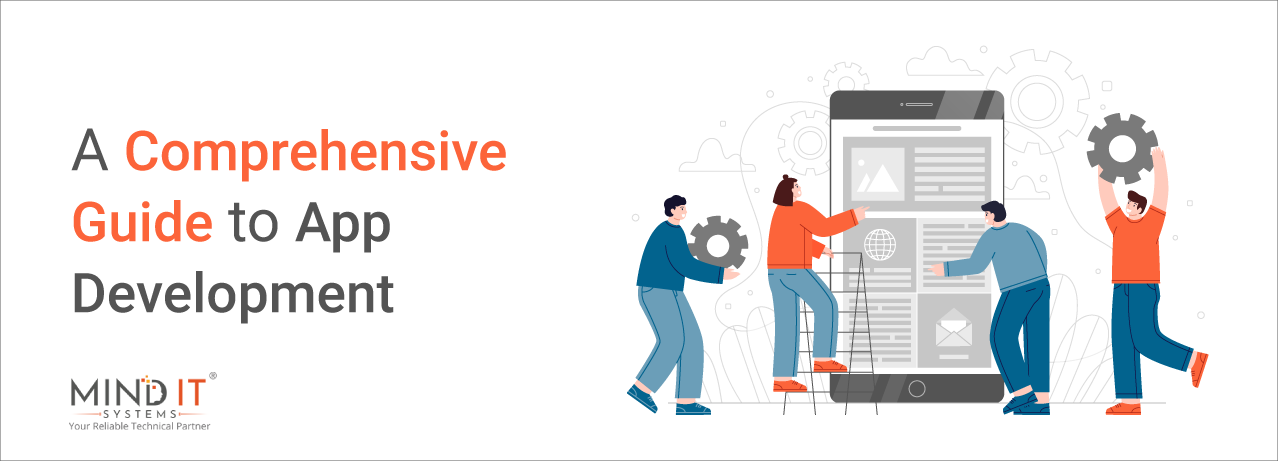
A Comprehensive Guide to App Development
Introduction
In today’s digital terrain, mobile and web applications have become indispensable tools for businesses, entrepreneurs, and organizations of all sizes. Whether you’re a visionary entrepreneur with a groundbreaking idea or an established business looking to expand your digital footprint, understanding the nuts and bolts of app development is vital.
Entrepreneurs, business owners, and organizations can benefit from this comprehensive guide tailored to their needs. This provides a detailed, step-by-step roadmap of the complex app development world. By the end of this app development guide, you might be well-equipped with the knowledge and strategies needed to create a mobile or web app that aligns with your business objectives and stands out in a competitive market.
Chapter 1: Setting the Foundation for App Development
1.1 Identify Goals
Before embarking on your app development journey, clearly defining your goals is essential. Start by answering these fundamental questions:
- What specific problem does your app aim to solve?
- How can your app benefit your target audience?
- What are the specific objectives you want to achieve with your app?
Understanding your goals is the cornerstone of a successful app development process. It sets the direction for every subsequent step.
1.2 Research Your Market and Competitors
In-depth market research is the backbone of a successful app. It involves:
- User Analysis: Understand your target audience’s demographics, preferences, and pain points.
- Market Trends: Stay up to date with current industry trends and emerging technologies.
- Competitive Analysis: Study your competitors’ apps to identify the market’s strengths, weaknesses, and opportunities.
This research phase provides the insights to make informed decisions about your app’s design and functionality.
1.3 Choose the Right Platform
The choice between developing for iOS, Android, or both platforms primarily depends on several factors, including your target audience’s preferences, geographical distribution, and budget constraints. Careful consideration of these factors can ensure your app reaches the widest audience possible.
1.4 Select Monetization Models
It is essential to examine various monetization strategies in app development to ensure the sustainability and profitability of your app. Consider options such as:
- In-App Advertising: Display ads within your app.
- Freemium Models: Offer a free version with premium features.
- Subscription-Based Pricing: Charge users repeatedly.
- One-Time Purchases: Allow users to buy your app or specific features outright.
The choice of monetization model should align with your app’s nature and the expectations of your target audience.
Chapter 2: Planning and Analysis
2.1 Define Functional and Non-Functional Requirements
Create a complete list of features and functionalities that your app must have. Additionally, consider non-functional aspects in your app development process, such as:
- Performance: How fast and responsive should your app be?
- Scalability: Can your app handle increased user loads?
- Security: How will you protect user data and privacy?
These requirements serve as the foundation for your app’s development.
2.2 Develop a Product Roadmap
An app development roadmap outlines the milestones and timelines for your project. Maintaining an app development plan keeps you organized and on track.
Critical components of a product roadmap include:
- Feature Prioritization: Identify which features to build first based on their importance and feasibility.
- Development Phases: Plan different stages of development, such as alpha, beta, and final release.
- Timelines: Set clear timelines for each development phase.
- Contingency Plans: Anticipate potential challenges and establish contingency plans to address them.
A well-crafted roadmap is an invaluable tool for project management and stakeholder communication.
2.3 Select the Right Tech Stack
Selecting the appropriate technology stack is crucial to your app’s success. The technology stack includes programming languages, frameworks, and databases for your app’s development.
Consider factors like:
- Development Speed: Some technologies may enable faster development.
- Scalability: Ensure that your chosen stack can accommodate your app’s growth.
- Maintenance: Evaluate the long-term maintenance requirements for your selected technologies.
Picking the right tech stack can significantly impact your app’s performance, development speed, and long-term viability.
Chapter 3: Designing an Engaging User Experience
3.1 Create Information Architecture & Workflows
Your app’s information architecture and user workflows lay the foundation for a seamless and intuitive user experience. Key steps in this process include:
- User Personas: Develop detailed user personas to understand your target audience better.
- User Flows: Create comprehensive user flows and use cases to map out user interactions.
- Simplicity and Clarity: Prioritize simplicity and clarity in your app’s design to enhance usability.
3.2 Wireframes and Prototypes
Wireframes are visual representations of your app’s layout and functionality. They serve as a blueprint for your app’s design, allowing you to experiment with different layouts and gather feedback early in the process.
Interactive prototypes take wireframes to the next level. They allow you to create simulations of the user experience, enabling you to test and refine your app’s functionality and usability before development begins.
3.3 Design Style Guides and Mockups
Establish style guides that define visual elements such as colors, typography, and iconography to maintain design consistency throughout your app.
High-fidelity mockups provide a detailed visual representation of your app’s final look and feel. They ensure your design ideas translate precisely into the app’s user interface.
Chapter 4: The App Development Phase
4.1 Frontend Development
Frontend development involves creating your app’s user interface and user experience components. During this phase, developers focus on turning your app’s design into a fully functional and interactive interface. They must adhere to best practices for coding and innovation to ensure a high-quality user experience.
4.2 Backend Development
Backend development involves building the server-side logic, databases, and APIs that power your app’s functionality. Security, scalability, and data management are critical considerations during this phase. Robust data security measures, efficient database queries, and disaster recovery plans are essential to well-designed backends.
Chapter 5: Testing and Quality Assurance
5.1 Security Testing
Thorough security testing is essential in safeguarding user data and protecting your app against potential vulnerabilities and breaches. Activities include penetration testing, data encryption, and authentication mechanisms to ensure data security.
5.2 Functional Testing
It is essential to thoroughly test all features and functionalities of your app to ensure they meet defined requirements and work as intended. Creating comprehensive test cases and scenarios and automating testing processes can improve efficiency and test coverage.
5.3 Performance Testing
Evaluating your app’s performance under various conditions is critical for optimizing its speed and responsiveness. Load testing, resource monitoring, and ongoing optimization are vital activities in this app development phase.
Chapter 6: Deployment and Launch
6.1 Prepare for Launch
As you approach the launch of your app, it’s essential to:
- Submit your app to the relevant app store (Apple App Store, Google Play Store).
- Ensure compliance with app store guidelines and requirements.
- Test your app on various devices and OS versions to ensure compatibility and performance.
Chapter 7: Post-Launch Support and Monitoring
7.1 Provide Ongoing Support
After your app’s launch, ongoing support is crucial for maintaining its functionality and addressing user issues promptly. This may involve bug fixes, updates, and user inquiries.
7.2 Monitor App Performance
Continuous monitoring of your app’s performance is essential to promptly identify and address any issues. Collecting user feedback and implementing user-requested features can help improve your app’s overall quality.
What’s Next in Your App Development Journey?
Now that you’ve traversed the crucial steps of app development outlined in this comprehensive guide, you may wonder what lies ahead on your journey to app success. This is where Mind IT®, an award-winning custom application development company with a remarkable track record, steps in to take your vision to new heights.
How can Mind IT® help you reach your goals?
Expert Guidance
Mind IT® offers expert guidance at every stage of your app development journey. Whether you’re at the conceptual stage, require assistance with UI/UX design, or need support during deployment and beyond, our seasoned professionals come up with invaluable insights and solutions.
Tailored Solutions
Recognizing that your app development needs are unique, we specialize in crafting tailored solutions that align seamlessly with your business objectives. Our goal is to ensure that your app meets and exceeds your expectations.
Cutting-Edge Technology
Remaining at the forefront of technology is prime in app development. At Mind IT®, we harness cutting-edge tools, programming languages, and frameworks to create high-performance, innovative apps (mobile, web) that stand out in the competitive market.
Ongoing Support
Mind IT®’s commitment to your app’s success extends far beyond deployment. We offer comprehensive custom app development support and performance monitoring services to keep your app running smoothly, secure, and at the forefront of the competition.
Growth and Innovation
Growth and innovation are keys to sustained success in the ever-changing app development landscape. Our committed team collaborates closely with clients to improve their apps, implement updates, and uncover innovative opportunities that keep your app relevant and engaging.
Continue Your Journey with Mind IT®
With Mind IT® as your trusted tech partner, your app development journey doesn’t stop; it evolves. We are here to guide you, provide tailored solutions, leverage cutting-edge technology, offer ongoing support, and drive growth and innovation.
Make the most of the chance to enhance your app’s potential! Contact us today and discover how we can help you achieve success with your app.
Get started on your app development journey today
The possibilities are endless!
Share this post
About the Author

Sujoy Roy
(Head – Digital Marketing)
From my teenage time, I had a quench to solve problems and loved leadership. Starting my career in relation management, ignited my passion for managing people. While managing I realized technology needs to be incorporated to keep pace with the changing world & do my work efficiently.

